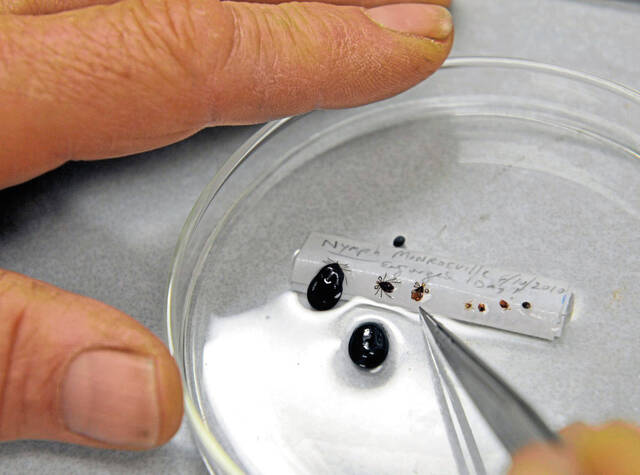https://mirror.triblive.com/local/regional/pennsylvania-tick-survey-turns-up-concentrations-of-rare-powassan-virus-variety/
Pennsylvania tick survey turns up concentrations of rare Powassan virus variety

In the final year of a statewide tick surveillance program that began in 2018, state researchers are seeing a troubling uptick in a form of Powassan virus carried by black-legged ticks, the same species that spreads Lyme disease.
Deer tick virus was present in more than 80% of tick samples taken recently from three sites: Lawrence Township Recreational Park in Clearfield County, Fisherman’s Paradise fishing area in Centre County, and the Iroquois Trail near Tunkhannock on Wyoming County, according to officials from the state’s Department of Environmental Protection.
Previously, the highest infection rate for the virus in a state sample was 11%, and DEP officials said the highest nationally reported infection rate in available scientific literature was only 25%.
The state’s research included fall and winter surveillance focused on analyzing adult black-legged ticks for emerging and changing disease burdens in public recreation areas statewide, such as parks, playgrounds, recreational fields and state game lands. The majority of results showed what researchers already know: there are a lot of Lyme-infected ticks out there.
“The health department estimates there’s about one Lyme disease case for every 100 people,” said Pennsylvania Department of Health Physician General Dr. Denise Johnson.
In addition to the annual bump in outdoor activity that comes with spring, fisherman itching for the start of trout season and hunters gearing up for spring gobbler turkey hunting will be brushing up against all of the foliage where ticks look for their next meal.
Deer tick virus
DEP has posted signage to alert the public about Deer tick virus and will conduct control measures and additional testing to reduce and monitor the number of ticks present in the recreational areas with high positivity rates for DTV, which is present in 15 Pennsylvania counties.
Deer tick virus is a type of Powassan virus. It is rare in the United States, but positive cases have increased in recent years, according to state officials. It is spread to people primarily by bites from infected ticks and does not spread person-to-person through coughing, sneezing or touching.
Initial symptoms of a DTV infection may include fever, headache, vomiting and weakness. Some people who are infected with DTV experience no symptoms, and therefore infection may go undetected. However, 91% of patients treated for DTV infections develop severe neuroinvasive disease.
Those who exhibit severe disease from Deer tick virus may experience encephalitis or meningitis and require hospitalization, with symptoms including confusion, loss of coordination, difficulty speaking or seizures.
Powassan virus can be transmitted from tick to human in as little as 15 minutes after a bite occurs, while other tickborne diseases, such as Lyme disease, take much longer to cause infection, often 24 hours or more after the tick attaches to the host. There are no vaccines to prevent or medicines to treat Powassan viruses. Preventing tick bites is the best way to reduce risk of infection and disease.
Ticks are a particular problem in Pennsylvania, which regularly leads the nation in the annual number of Lyme disease infections, according to figures from both the state health department and the Centers for Disease Control.
Ticks in the yard?
But while it might seem like a walk in the woods is the most likely place to encounter a black-legged tick, that’s not necessarily so, according to Nicole Chinnici, director for the Tick Research Lab of Pennsylvania at East Stroudsburg University. In fact, the higher risk is usually closer to home than most people probably want to think about.
“The way our geographical layout is set, residential properties are smack dab in the middle of forested areas,” Chinnici said.
“That’s where you’re going to get higher rates of deer coming into yards and a higher incidence of ticks.”
The lab asks residents who find a tick on them to record data — where they were prior to its discovery, what they were doing when exposed — as well as send them the actual tick itself, which is officially identified, tested and recorded in the lab’s data set.
Of nearly 40,000 ticks tested from Pennsylvania, 32% have been infected with the Borrelia spirochetes that cause Lyme disease.
But that is not the only tick-borne illness. Other varieties include anaplasmosis, babesiosis and Powassan virus, among others.
Taking that into account, infected tick numbers climb as high as 70% depending on the region, according to the lab’s data.
So why Pennsylvania? Chinnici said the climate has much to do with it.
“Our temperate environment suits tick survival very well,” she said. “Plus we have a large state with a lot of rural landscape and forested areas. And we have a healthy wildlife population that ticks seek out.”
That even includes this time of year, she said.
“Another myth is most people believe that once winter hits, there’s no risk of ticks,” she said.
“Ticks will survive for up to two-and-a-half years underground and they come out, basically, starving, once the snow melts. Anytime it’s above freezing, ticks can be out and about.”
For more, see TickLab.org.
Copyright ©2025— Trib Total Media, LLC (TribLIVE.com)
